|
Advocacy
|
|
Can't see the form? Click here» |
|
Advocacy
|
Rodeos: Inherent Cruelty to Animals
January 15, 2015
by Peggy W. Larson, DVM, MS, JD
During the course of my lifetime, I have been a farmer, a bareback rodeo bronc rider, a large animal veterinarian, a medical researcher, a meat inspector, a state veterinarian, and a prosecutor. I have also worked as a media consultant on animal welfare issues including rodeo and PMU (pregnant mare’s urine) horses. Based upon my extensive large animal experience, I have concluded that rodeo events are inherently cruel.
Calf Roping
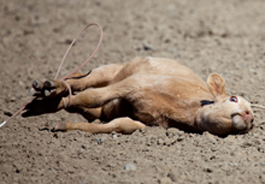 Sascha Burkard/iStockphoto Sascha Burkard/iStockphotoThe cruelest rodeo events are the roping events. In calf roping, baby calves are used. If they were not in the rodeo, these calves would still be with their mothers on pasture. Weighing less than 300 pounds, they are forced to run at speeds in excess of 25 miles per hour when roped. The reason they run at such high speeds is that they are tormented in the holding chute: their tails are twisted, their tails are rubbed back and forth over the steel chute bars, and they are shocked with 5000-volt electric prods until the gate opens. They burst out of the chute at top speed only to be stopped short – or “clotheslined” – with a choking rope around the neck. They are often injured, and some are killed.
It is also the case that rodeo calf ropers must spend a great deal of time practicing in order to become proficient. Calves sold to practice pens are roped over and over until they are injured or killed. Dr. T. K. Hardy, a veterinarian who was also a calf roper, was quoted in Newsweek, stating that calf roping is an expensive sport, and that two or three calves are injured per practice session and must be replaced.
Many rodeo insiders also believe that calf roping is cruel. These include such notables as Dr. Robert Miller (rodeo veterinarian), Chuck King (Editor of Western Horseman), John Growney (stock contractor), Keith Martin (San Antonio Livestock Exposition Director), Cotton Rosser (stock contractor) and Monty Roberts (horse trainer).
Steer Tripping
As with calf roping, steer tripping—commonly called “steer busting”—puts a rodeo animal at extreme risk of injury or death. Steers weighing approximately 700 pounds are forced to run at top speed while the roper throws the rope around the steer's horns. The roper then flips the rope over the right side of the steer, while turning his galloping horse to the left. Within a split second, the steer's head and neck are jerked 180 degrees or more, causing the animal to be violently tripped, rolled and dragged for approximately 30 feet. That's a 700-pound body being dragged by the neck, with the horns digging into the dirt. Sometimes the horns fracture. The stress to the neck is enormous. The roper's intent is to make the steer sustain a violent fall and subsequent dragging sufficient to stun the steer. The purpose of the stunning is to enable the roper to tie the steer's legs for a score. If the steer is not sufficiently stunned in the first attempt, he may be tripped and dragged repeatedly in the same run until he remains down.
These steers are usually very thin, often with sores on their backs and hips. They appear to be depressed, not lively. They are used so often that their injuries do not have enough time to heal. As with roping calves, tripping steers may be used over and over again in practice sessions. When they are crippled from repeated abuse and injury, they are sent to slaughter.
Steer Wrestling
Steer wrestling also causes injuries and deaths to the animals. In this event a steer is forced to run at top speed while a contestant leaps from his horse, grabs the horns of the steer and twists his neck until he falls to the ground. In one case involving a rodeo steer in Connecticut, the steer did not fall when the rider jumped on his head. The competitor then violently twisted the steer's head, again. When he fell, the steer suffered a broken neck.
Bull Riding
Bull riding may appear less harmful, as the bulls are so large. However, in order to enhance the bull's performance, cattle prods are often used repeatedly to shock the bulls as they stand trapped in the bucking chute. Bucking straps and spurs can cause the bull to buck beyond his normal capacity and his legs or back may thus be broken. Eventually, when bulls cease to provide a wild ride, they too are sent to slaughter.
Rodeo-Related Injuries Evident at Slaughter
As a pathologist and former meat inspector, I believe my colleagues when they report horrendous injuries to rodeo cattle. Dr. C. G. Haber--a veterinarian with thirty years of experience as a USDA meat inspector--says, "The rodeo folks send their animals to the packing houses where...I have seen cattle so extensively bruised that the only areas in which the skin was attached was the head, neck, legs, and belly. I have seen animals with six to eight ribs broken from the spine and at times puncturing the lungs. I have seen as much as two and three gallons of free blood accumulated under the detached skin."1
A career USDA meat inspection veterinarian, Dr. Robert Fetzner, Director of Slaughter Operations for the USDA Food Safety and Inspection Service, stated in our phone conversation on September 9, 1998, "Lots of rodeo animals went to slaughter. I found broken ribs, punctured lungs, hematomas, broken legs, severed tracheas and the ligamenta nuchae were torn loose." Torn nuchal ligaments are essentially broken necks and this is the sad fate of many roping calves.
Bronc Riding
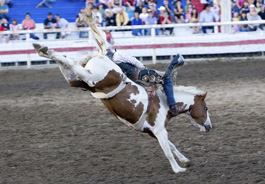 iStockphoto iStockphotoBronc riding, both saddle and bareback, causes rodeo horse deaths. It is not uncommon for horses in these events to crash blindly into fence posts around the arena or into the holding fencing and chutes. Bucking horses must be spurred over the shoulders on each jump or buck in order for the rider to qualify. The spurs cause blunt trauma to the shoulders which don’t have time to heal properly before the horse is ridden and spurred in another rodeo. The bucking strap can also cause chafing to the flank area which increases the discomfort to the horse. The irritation of the spurs and the bucking strap often cause the horse to "run blind" and fail to see fencing, posts or chutes.
Rodeo Transport
Rodeo animals are constantly in transit. Horses and cattle are shipped from one rodeo to the next, often in double-decker trailers. These trailers are very dangerous because the horses often fight during transport and fighting may also occur when bulls are shipped.
Dr. Temple Grandin of Colorado State University works with the cattle industry on humane handling of its animals. In several phone conversations, she referenced a case in which a bucking horse suffered a badly broken front leg. Instead of humanely euthanizing the suffering animal, the rodeo chose to ship the horse, her leg dangling, across two states in a transport truck along with other horses. She died before she could be killed at the slaughterhouse. Dr. Grandin also stated that transport injuries and fighting are major causes of injuries in shipped horses.
The Effects of Normalized Rodeo Violence on Children
Rodeo not only injures and kills many animals, but it exposes children to sanctioned animal abuse. As a former prosecutor, I saw many criminals that had a history of animal abuse. Children who attend rodeos witness riders and ropers dominate and injure animals. They see the spurs, the cattle prods and the ropes. They see brutal riders winning prizes. Animal abuse can become acceptable to them. Acknowledging this link, Planned Parenthood has stopped using rodeo in its national fundraising efforts because of their concern for children and for the animals.
Mutton Busting for Kids
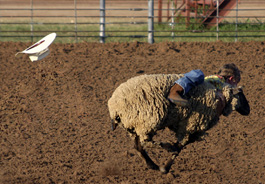 iStockphoto iStockphotoRodeo now also promotes small children riding sheep—this event is called “mutton busting.” Four- to six-year olds are sometimes forced by their parents to ride sheep at rodeos. Some kids are crying from fear. Some kids are injured and suffer broken bones, head injuries and abrasions. The potential for injuries is so great that parents are required to sign a waiver absolving the rodeo from legal action in the event of injury.
Children and Rodeo Tobacco Marketing
Rodeo promoters have used children to distribute free samples of tobacco products—mainly chewing tobacco¬—to rodeo attendees. When Bozeman, MT was selected to hold the National Collegiate Rodeo finals, the tobacco industry wanted to use children to pass out tobacco samples at the event. However, when Bozeman city officials denied permission, rodeo promoters went elsewhere.
Anti-Rodeo Legislation
A number of cities across the country have passed ordinances eliminating rodeo's most common devices--the electric prod, spurs and the flank strap--all of which use pain to force the animals to "perform." These include Pasadena (CA), Fort Wayne (IN), Pittsburgh (PA), Leestown (VA), and the state of Rhode Island. It is no accident that where these devices are eliminated, rodeos disappear. Internationally, both the UK and the Netherlands have banned rodeos outright.
Numerous animals – including calves, steers and horses – are routinely injured and killed in rodeo events. If desired, many rodeo videos can be viewed publicly via YouTube.
In my opinion, and based on my extensive training and experience, it is impossible to create a humane rodeo.
1. The Humane Society of the United States, interview with C.G. Haber, 1979.
Dr. Peggy Larson was born on a North Dakota grain and cattle ranch. She studied veterinary medicine at The Ohio State University, earned a Master’s in Comparative Pathology at UC Davis, and a law degree at Vermont Law School. After law school, Dr. Larson clerked as a state prosecutor. As an associate professor, she taught at one of the Vermont state colleges and she has also worked as a media consultant on a variety of animal issues. Her veterinary patients have included ranch cattle and horses, swine, sheep, dogs and cats. She recently retired from the spay/neuter practice she established in 1991. Dr. Larson currently uses both her veterinary and law degrees to investigate animal cruelty cases and to serve as an expert court witness. |
|
|
Advocacy
|
California Implements Landmark Farm Animal Welfare Laws in 2015
Strong Veterinary Support Helped Pass Prop 2
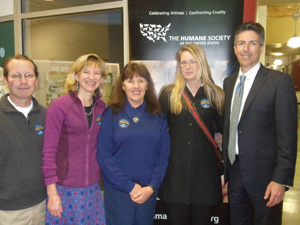 HSVMA staff join Wayne Pacelle, President & CEO of The Humane Society of the United States, in celebrating the implementation of California's Proposition 2 in Sacramento on January 9. HSVMA 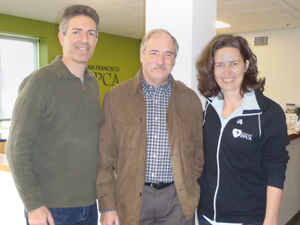 The celebration continued the following day at the San Francisco SPCA with HSVMA-RAVS veterinarian, Dr. Paul Breckenridge, and SFSPCA Co-President, Dr. Jennifer Scarlett. HSVMA
California veterinarians appeared in television commercials like this one to voice support for Proposition 2.
January 14, 2015
by Barbara Hodges, DVM, MBA – HSVMA Veterinary Advisor
HSVMA joins animal welfare advocates throughout California and nationwide in celebrating implementation of California’s Proposition 2, the nation’s most comprehensive farm animal protection law. The measure, which took effect on January 1, requires that egg-laying hens, pregnant sows and calves raised for veal have enough room to stand up, turn around and fully extend their wings or limbs. Prop 2 was passed in 2008 by an overwhelming 64% of California voters, including strong support from California’s veterinary community. There was a six-year phase-in period, which ended December 31.
Another state law (AB 1437, passed in 2010), also commencing in 2015, requires that all whole eggs sold in California be produced under conditions that conform to the new animal care standards established by Proposition 2. All eggs sold in California must now be produced by hens able to stand up, fully extend their limbs, lie down and spread their wings without touching each other or the sides of their enclosure, thus essentially requiring cage-free conditions for the birds.
Veterinary support for Prop 2 was led by HSVMA along with more than 700 individual veterinarians, 90 veterinary hospitals and 150 veterinary medical students throughout California who endorsed the measure. In addition, the California Veterinary Medical Association publicly endorsed Prop 2 with the CVMA Board of Governors recognizing that it was clearly aligned with their organization’s Eight Principles of Animal Care and Use. Professional leadership support was voiced at local levels as well, with the San Diego County and Marin County VMAs adding their endorsements.
Many compassionate veterinary professionals throughout California, including several HSVMA members, committed time, energy and resources to help pass Proposition 2. Efforts ranged from gathering signatures to get the measure on the ballot, to garnering endorsements from colleagues and making presentations at VMA meetings.
Some veterinarians were even more public in their activism, writing letters to the editor, submitting opinion pieces to media outlets, meeting with editorial boards, attending press conferences and appearing in television spots to help spread the word that the profession supported Prop 2 (view one of these commercials at right).
The public looks to the veterinary profession for leadership on animal welfare issues. In the case of Proposition 2, the California veterinary community clearly demonstrated this leadership by endorsing an unprecedented animal welfare reform that will benefit millions of farm animals. The impact of these reforms has already reverberated in California and nationally--elevating awareness about the plight of animals raised for food, and ushering in greater consumer demand for cage-free products and a new era of higher-welfare animal agriculture across the country. HSVMA looks forward to working with the veterinary profession on other similar landmark animal welfare reforms. |
|
Advocacy
|
| MEMBER SPOTLIGHT: Dr. Jean Rabinowitz |
4 R Friends Sponsors Neighborhood Dog Days
| About 4 R Friends |
| Founded in 2010 by Dr. Jean Rabinowitz, 4 R Friends is a Sacramento, Calif.-based non-profit, all volunteer, organization dedicated to providing life-saving emergency medical care to stray, sheltered, and owner-relinquished pets, and to providing essential care and sharing information to insure that all pets in our community can live safe and healthy lives. Learn more about 4 R Friends» |
December 19, 2014
by Jean Rabinowitz, MA, DVM
It started as a campaign to stop the epidemic of parvoviral enteritis in a Sacramento neighborhood. Each time another unvaccinated puppy – whose owner could not even afford the $98 emergency exam fee – came in during my emergency clinic shift, I would tell the technicians that my desired super-power would be to put an end to parvo. I would even promise to wear a spandex suit and a cape in public, if I could just figure out how to achieve that monumental feat.
After all, why should it be so hard? We understand how the virus is transmitted, and we have an excellent safe and effective vaccine against it. At less than $2.50 a dose, it’s not even a costly tool. The shelters and various pet stores in the Sacramento region hold free and low-cost vaccine clinics regularly. ...so why was I seeing puppies with parvo nightly in the late summer? Why were our shelters seeing dozens of cases weekly? With the cost of treating parvo patients in the hospital potentially surpassing $2,000 a case, and with its incredible potential for contagion, the most common outcome for these poor creatures was euthanasia—or even worse, a slow and painful death at home.
A Clear Need for Outreach
An exercise in mapping vaccine clinic locations was enlightening. I found that – including those held at the three Sacramento animal shelters and all the low-cost vaccination clinics – 252 events were held within the area each year. When plotted on a map, however, they told a stark story of inequity that mirrored so many others nationwide. Whole swaths of Sacramento were completely unserved by any clinics. Those were the same areas of the community where parvo was rampant. Not surprisingly, they also represented the greatest per capita intake of stray, injured, and aggressive dogs, and the greatest intake of stray or injured cats and orphaned kittens. A look at the outcome statistics for our shelters, sorted by zip code, showed that pets from these neighborhoods have a markedly lower-than-average return-to-owner and live-release rate.
A look at US census reports helped fill out the story of the neighborhoods where pets are at a so much higher risk of preventable death, whether it be by parvo, vehicular trauma, or euthanasia at the shelter. These neighborhoods share the common traits of high rates of poverty and recent immigration, and low rates of home ownership and educational achievement. In other words, they are the areas where low-cost and accessible basic care for pets is most needed. They are communities in which our typical standards of responsible pet care may be entirely foreign to the residents. Taking a ride around these neighborhoods, I saw broken-down gates, bent chain-link fencing, and young men riding bicycles equipped with lawn-mower engines for transportation. I saw dogs running loose on nearly every block, wearing no collars or tags. Young women, barely beyond childhood themselves, were walking with their own babies past houses where litters of kittens tumbled out from under porches. Syringes and needles littering the ground told a story of degradation and pain that is hard to fathom from the safety of my office at the emergency clinic.
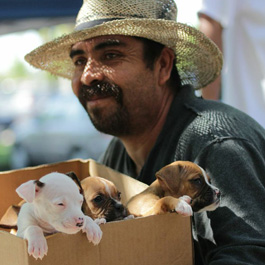 A Sacramento resident brings a box full of puppies to a clinic. 4 R FriendsWe can discuss ad nauseam the long history of oppression and inequities that has led to this current state of affairs. But saying that people who cannot afford to care for their pets should not have them, when we know that the average cost of pet care can be $500 a year and more than $8,000 over the life of a pet1, does not help the dog who may be the best thing a neighborhood kid has going for him. It does not help the dog stuck in the shelter who is going to be euthanized tomorrow because his owner has neither the government-issued ID nor the $45 impound fee required to get him out of the shelter. It will not change the fact that dogs and cats will continue to multiply, and will continue to be bought, given, adopted, and loved as members of many families. And as long as access to care is limited and puppies and kitties are a dime a dozen, pets will continue to die for want of care. It is not within our power to change that, and no amount of moralizing or righteous indignation will help these animals.
However, it is not hard at all to bring $2.50 vaccines, collars, and that all-important ticket – an ID tag – back home for stray dogs, and the information people need to keep their pets happy, healthy, and at home, to these neighborhoods. So that is what we do.
Making Connections and Filling the Gap
In 2012, 4 R Friends held our first series of three Neighborhood Dog Days – free clinics in south Sacramento – and we have increased our range and frequency annually. We recruit participation from the neighborhoods by hitting the streets with flyers, stopping in at local barber shops, corner stores, beauty salons, bodegas and churches. In so doing, we help ensure we are reaching the intended recipients of our program.
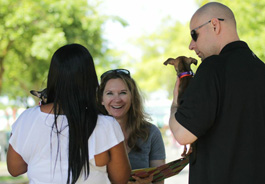 A 4 R Friends volunteer gathers information from clients about their dogs. 4 R Friends4 R Friends gathers 80 or so skilled and enthusiastic volunteers – including veterinarians, veterinary technicians, advocates, and community leaders – to erect a tiny temporary village at the local library each clinic day. We handily leverage our $5,000 per-clinic budget with donations, discounts, and borrowed equipment, and collaborate with every willing shelter and community organization. We provide rabies and DAPP vaccines, flea prevention, and deworming. Every dog leaves with a leash, a collar and an engraved ID tag around their neck. We offer information on protecting puppies from contracting parvo. We dispense tips on house training, and leash training, to help people live more harmoniously and happily with their pets. We take contact information from every client interested in spaying or neutering their dogs and cats, and work to get them signed up through every free or low-cost surgery program available in the county. When possible, we borrow a mobile surgery trailer, and perform spays and neuters on-site.
As we continue to perfect our process, we have increased our services to include addressing more general medical problems. In addition to treating myriad ear infections and cases of flea-allergy dermatitis, we treat wounds, fox-tail abscesses, demodectic mange and parvo. We enlist students from the nearby University of California at Davis School of Veterinary Medicine to help at the vaccine stations and in the medical tent, offering them invaluable experience handling animals, further developing their client communication skills, and providing them with a taste of a kind of real-world practice they might never see otherwise.
For the majority of the dogs served, we are the only veterinary professionals they will ever see in their lives. And our services are all free. We make no requests for client identification, and no requirements to supply evidence of government assistance. We convey no shame to the owners of unaltered pets. And no requests for city or county license fees arrive in the mail soon after our clinics. We simply communicate admiration to our clients for their beloved pets, and gratitude to them for placing their trust in us to care for their furry family members.
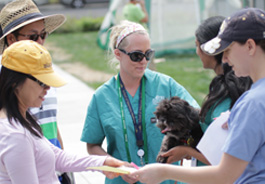 HSVMA member, Dr. Sarah Buckenberger, talks to a family about their dog at a 2012 event. 4 R FriendsA Successful Endeavor
Our approach works. The attendance has been unprecedented. Since our first field clinic, we have been serving between 400-500 dogs at each of our events. They have all been distinguished by a spirit of joy, gratitude, and cooperation, and we have had an unblemished safety record. The greatest compliment and affirmation that our strategy is working is that numerous clients have joined with 4 R Friends as steadfast volunteers, not only assisting with outreach and recruiting within their own neighborhoods, schools, and workplaces, but also working at each event as translators, dog handlers, and in intake reception roles.
In 2015, we will be holding our Neighborhood Dog Days clinics monthly in Sacramento, and we are on course to serve 6,000 dogs next year by providing the essential resources needed to keep them happy, healthy, and at home, off the streets and out of the shelters.
1 https://www.aspca.org/adopt/pet-care-costs
Editor’s Note: The Humane Society of the United States operates a program to provide services, resources, and information to people and pets in underserved communities through in depth community outreach. Many HSVMA veterinary and veterinary student members have participated in this program. To learn more, visit the Pets for Life webpage»
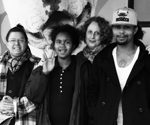 Dr. Rabinowitz (second from right) with a few happy 4 R Friends clients. 4 R FriendsJean Rabinowitz, MA, DVM, is the founder of the Sacramento, Calif.-based non-profit animal rescue and outreach organization, 4 R Friends. She practiced general and emergency medicine in private practice for ten years before joining the County of Sacramento Animal Care and Regulation as their second veterinarian, and head of their new community outreach program.
Dr. Rabinowitz obtained her veterinary medical degree at the University of California Dean Pritchard School of Veterinary Medicine at Davis. Before that, she contemplated problems of the body and pain in late antique and medieval history at the University of California, Berkeley and at Yale University.
When she is not vaccinating dogs, she can be found digging in the dirt of her back garden, playing with her herd of parvo-survivor pit bulls, and baking cakes. |
|
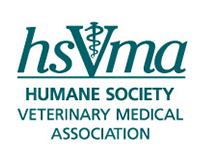



 iStockphoto
iStockphoto iStockphoto
iStockphoto





